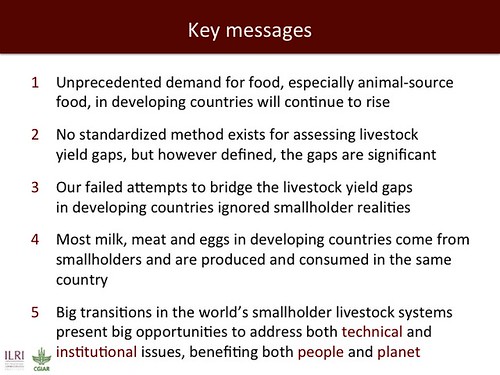Last week, Jimmy Smith, director general of the International Livestock Research Institute (ILRI), gave a presentation on closing the big livestock yield gaps in developing countries.
Smith made his presentation at the Global Food Security Consortium Spring Symposium, held in Ames, Iowa, 29–30 Apr 2014.
Below is the gist of Smith’s talk.
01 Demand for livestock foods will continue to be high
02 Most production and consumption of livestock products is within country
• 90% of livestock foods are consumed in the same country where they are produced
• While trade is increasing, it will not close the yield gaps we see
03 In these countries, it is smallholder producers who dominate the livestock sector
• Farms will aggregate over time, as they have elsewhere, but we will remain in a transition phase for another 20 to 50 years
• Smallholder livestock producers will continue to be important to food security till at least mid-century
• Globally, more than half of all livestock commodities are produced in smallholder backyard systems
• Most animal-source foods are still produced in smallholder systems
04 Defining yield gaps for livestock is problematical
• There is no standard way to analyse livestock yield gaps
• We haven’t defined our terms: Are we comparing developed countries with developing? Countries within the tropics? What can be obtained on experimental stations (and whose experimental stations?) versus what can be obtained in the field (and whose field?)
• However you look at it, there is a big difference in livestock yield gaps between developed and developing countries
05 Our past failures in livestock development in poor countries are due largely to our attempting to transfer technologies wholesale from industrial (temperate) nations to developing (tropical) nations
• We have attempted to transplant the livestock production systems of developed countries in developing countries through the importation of Holstein and other exotic high-yielding breeds to regions where they perform worse than the native animals of that region.
06 This essentially entailed a transfer of livestock genetic resources
• We focused on biological factors and genotypes, as though these were the whole answer to raising livestock yields
07 This approach worked moderately well for poultry and swine, whose environments and habitats can be relatively easily improved and controlled
08 But this approach did not work for dairy and beef production due to the greater difficulty and prohibitive expense involved in improving and controlling environments for these large (and less hardy) ruminants
• The answer to the yield gaps is not fancy breeds for the tropics
• It is more expensive to moderate environments to suit these exotic animals than to upgrade the native stock
09 We thus failed to match what we were trying to do with the needs of the small-scale livestock keepers we wanted to serve, to issues of equity and to ecological and environmental issues
• Such environmental issues include, in addition to local climate and circumstances, feed and health issues
• We failed to take into consideration how to manage livestock feeds and diseases and what institutional and policy changes would be needed
• We misdiagnosed both the problems and the solutions for smallholders
• It is clear now that genetics was not the only thing smallholders needed to upgrade their livestock production enterprises
• The animal we see, and its production, is generated by the genetic make-up of the animal (its genotype) plus the environment, plus the interactions between the genotype and the environment, with the environment here referring not only to natural resources but also to feed regimes, management practices, disease risks, ecological conditions, and so on.
10 Actual livestock yield gaps and how we might fill them
• Our rough analyses indicate that among smallholder livestock producers, one-third don’t have the conditions in which to be viable, one-third can go either way (success or failure) and one–third can be successful
• In filling these large yield gaps we have a new opportunity to get things right, and to address simultaneously people, equity and planet issues
• We have an opportunity to align our work so as to solve several problems at once, e.g. poverty, hunger and malnutrition and environmental degradation
• The livestock sector transition period we are entering in developing countries gives us tremendous opportunity to work on this simultaneous equation in the transformation of smallholder systems
• We must pay attention to the needs of the users of our interventions
• What we must not do is to attempt to fill the yield gap at any cost
• What we must do is to specify the main problems in smallholder livestock feed and health and what we can do about them, particularly locally for smallholders, e.g. how to: develop feed markets, match breeds with environments, make use of new genomic technologies like TALENS and new approaches to vaccine development, produce more digestible roughages, better control diseases, determine what diseases to pay most attention to, adjudicate between need for human food and livestock feed, etc.
• If we do this well, and approach filling the livestock yield gap properly, we could get three for one:
We can enable smallholder livestock producers to continue being large contributors
to food, nutritional, economic and environmental security
View the slide presentation by Jimmy Smith:
on Slideshare: Closing livestock yield gaps in the developing world: Imperatives for people and the planet, 29 Apr 2014
or
on Storify: View the story “Jimmy Smith on closing livestock yield gaps in developing countries” on Storify



Reblogged this on Let's Farm and commented:
Actual yields and productivity in livestock are much lower than potential due to a myriad of challenges. This talk by Jimmy Smith is enlightening. Enjoy!